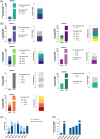Circulating tumor-associated and neoantigen-specific endogenous T cells in children treated for B-acute lymphoblastic leukemia
- PMID: 40625532
- PMCID: PMC12230863
- DOI: 10.1002/hem3.70171
Circulating tumor-associated and neoantigen-specific endogenous T cells in children treated for B-acute lymphoblastic leukemia
Conflict of interest statement
The authors declare no conflicting interest with the submission of this article.
Figures


Similar articles
-
Prediction of B/T Subtype and ETV6-RUNX1 Translocation in Pediatric Acute Lymphoblastic Leukemia by Deep Learning Analysis of Giemsa-Stained Whole Slide Images of Bone Marrow Aspirates.Pediatr Blood Cancer. 2025 Aug;72(8):e31797. doi: 10.1002/pbc.31797. Epub 2025 May 21. Pediatr Blood Cancer. 2025. PMID: 40399768
-
[Efficacy of Blinatumomab in the Treatment of Pediatric B-cell Acute Lymphoblastic Leukemia].Zhongguo Shi Yan Xue Ye Xue Za Zhi. 2025 Jun;33(3):698-705. doi: 10.19746/j.cnki.issn.1009-2137.2025.03.011. Zhongguo Shi Yan Xue Ye Xue Za Zhi. 2025. PMID: 40613158 Chinese.
-
Venetoclax-based regimen in refractory or relapsed pediatric acute lymphoblastic leukemia.Acta Haematol. 2025 Jul 8:1-18. doi: 10.1159/000547080. Online ahead of print. Acta Haematol. 2025. PMID: 40628245
-
CAR T-cells for acute leukemias in children: current status, challenges, and future directions.Cancer Metastasis Rev. 2025 Apr 23;44(2):47. doi: 10.1007/s10555-025-10261-7. Cancer Metastasis Rev. 2025. PMID: 40266383 Review.
-
The efficacy and safety of nelarabine in relapsed or refractory T-cell acute lymphoblastic leukemia: a systematic review and meta-analysis.Ann Hematol. 2025 Feb;104(2):1139-1155. doi: 10.1007/s00277-024-06121-z. Epub 2025 Jan 10. Ann Hematol. 2025. PMID: 39792179 Free PMC article.
References
-
- Majzner RG, Heitzeneder S, Mackall CL. Harnessing the immunotherapy revolution for the treatment of childhood cancers. Cancer Cell. 2017;31(4):476‐485. - PubMed
-
- Ceppi F, Beck‐Popovic M, Bourquin JP, Renella R. Opportunities and challenges in the immunological therapy of pediatric malignancy: a concise snapshot. Eur J Pediatr. 2017;176(9):1163‐1172. - PubMed
LinkOut - more resources
Full Text Sources
